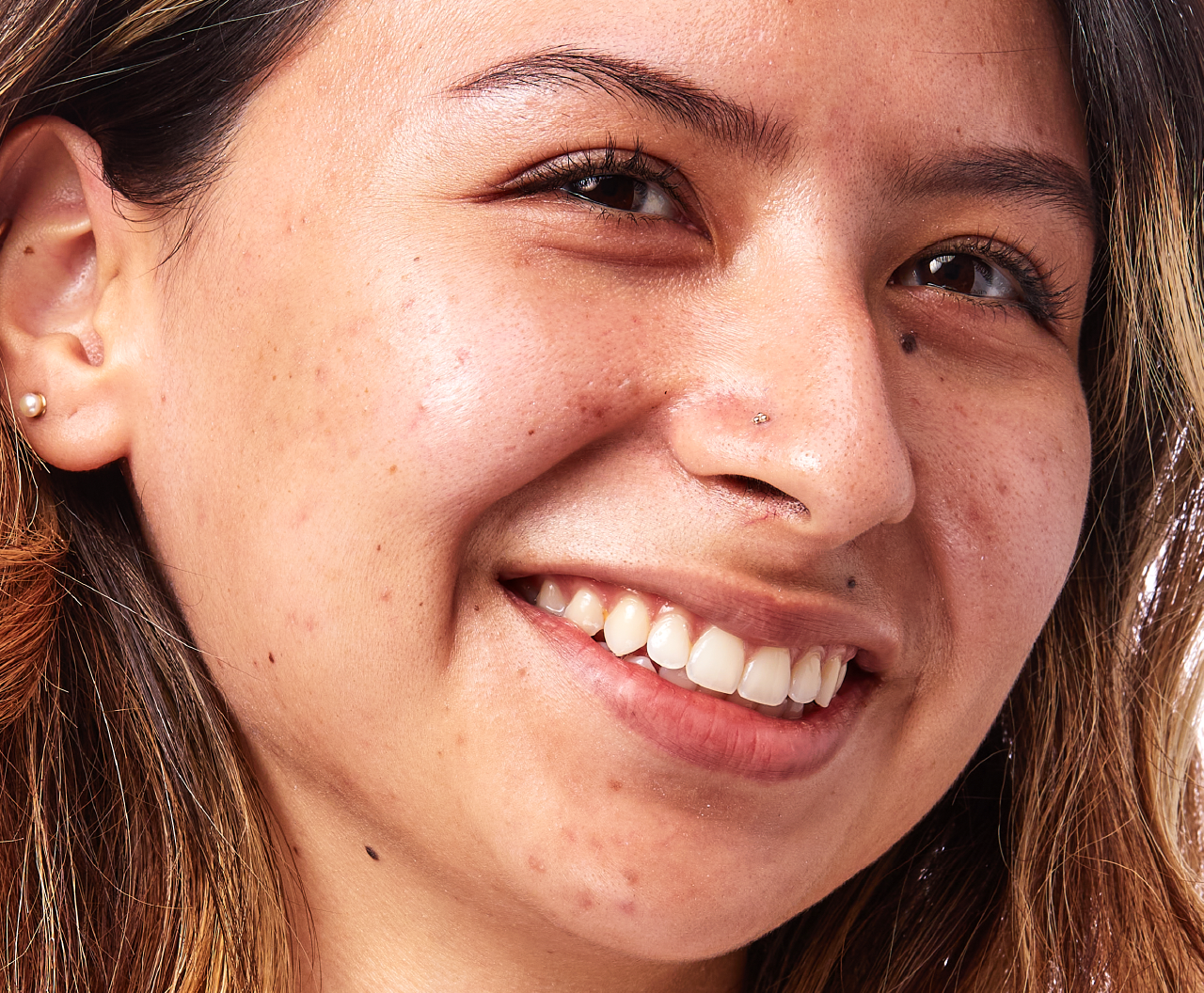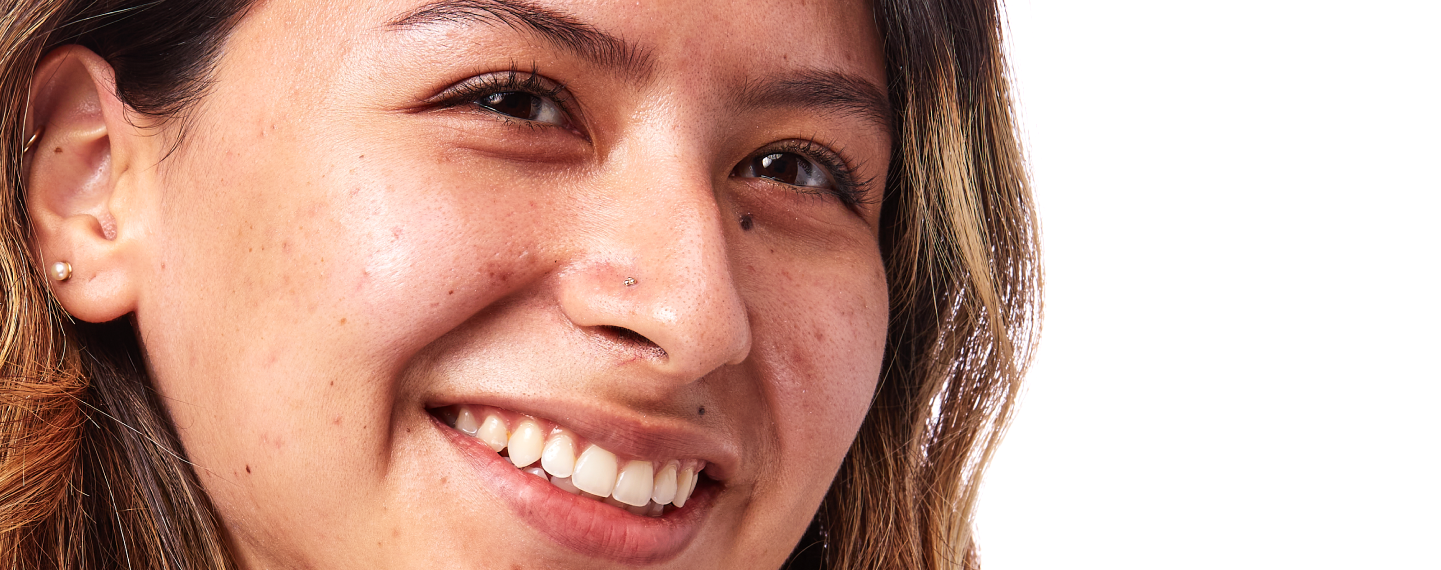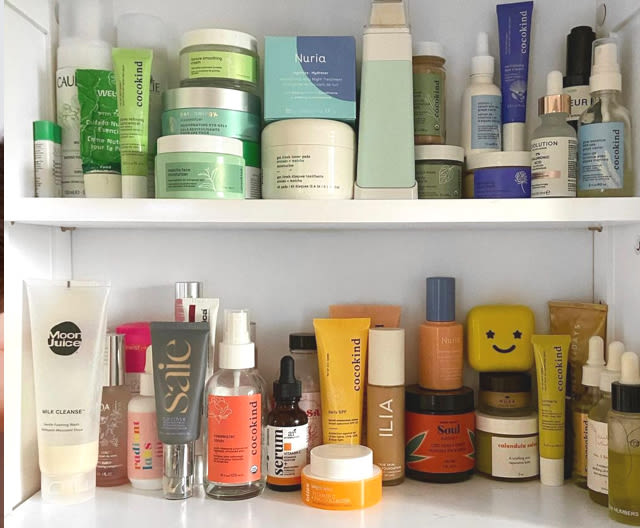Education
Does milk cause acne?


SHARE
Education
Does milk cause acne?
Medically reviewed by Kristin Hall, FNP
Written by Apostrophe Team
Last updated 4/1/2024
No matter where you’ve heard it, chances are someone has mentioned to you that the link between acne and milk intake is one of the problems faced by many generations of adolescents (and adults, for that matter).
Maybe someone read about clinical trials, maybe the news cited peer-reviewed studies, or maybe someone just really, really hates ice cream.
But the ubiquitous link between bad skin and dairy consumption seems to always be part of the conversation.
Could all those ‘90s “Got Milk?” ads be part of a generation of young people’s acne problems?
There are a lot of reports out there. Dairy intake (specifically that in a Western diet) has been accused of everything from making teen acne worse to causing increases in insulin resistance.
But rumors about growth hormones aren’t what we’re here to discuss. The fact is that the link between cow milk consumption and mild to severe acne is far from understood, and while there is evidence to suggest that going overboard on ice cream might play a role in acne, it’s far from proven.
To understand the relationship between dairy and pimples, we need to first explore the link between the occurrence of acne and dietary factors generally. Let’s start with the basics.
How Diet Affects Your Skin and Can Cause Acne
Remember the old saying, “You are what you eat?” Well, in the world of skin health, that’s at least partly true.
Your diet plays a role in the healthy functioning of your skin, which requires a balance between hormones, oils, skin cell production, and other processes that are fueled by the food you consume.
But it’s not as simple as “greasy food equals greasy skin.” In fact, greasy foods may have little to do with how your acne fluctuates. Instead, it might have more to do with hormones.
It’s helpful to think about this first in terms of fried chicken. Because why not?
Fried chicken is, by most peoples’ standards, a pretty greasy food. Delicious, yes — but greasy.
And if you eat a drumstick or two and then have an acne break out in the subsequent couple of days, you would probably equate your skin issues to the grease in the chicken.
Realistically, however, the chicken’s role in your acne could have more to do with, say, the antibiotics, bovine growth hormones, and other things in the chicken itself, rather than the frying medium.
There’s a lot to unpack.
Does Milk Cause Acne?
So, what about milk and dairy? Do those cause acne, too?
Believe it or not, the case against milk is building. But it’s important to understand that there are many questions we don’t know the answers to.
So before you go throwing the milk out with the bathwater, here are some data points you should consider.
It’s important to understand that, at least with regard to acne, there is a difference between dairy milk and other dairy products like yogurt or cheese.
Studies have shown that there may indeed be a link between milk consumption and an increased risk of acne lesions.
The meta-analysis, however, failed to identify a cause or significant difference between other dairy products and milk.
For that, we have to go elsewhere. One theory suggests that the relationship between acne and milk may have to do with insulin.
Because dairy products can increase insulin levels, it’s believed that dairy products like milk can stimulate the over-production of certain hormones associated with acne — the same androgen hormone category that teenage bodies frequently overproduce during puberty (and sometimes beyond).
The Link Between Milk Consumption and Acne
One study from 2019 found a link between milk consumption and adolescent acne problems, and while researchers did not outline a particular theory about why milk may play a role in acne, they likewise pointed to chicken as another food whose consumption may be related to acne.
Further, the researchers found that consuming whole milk multiple times a week could contribute to moderate to severe acne and that glasses of low-fat milk or glasses of skim milk were associated with lower risks of acne.
This would seem to support at least the theory that insulin-modifying compounds and hormones in these foods may play a role in acne issues for those consuming them.
Again, much of this research begs further questions, rather than answering any of them. Instead, we’re left to theorize about the real causes — with little in the way of recommendations to make about whether you should leave the cream out of your coffee.
Alternative Milks to Consume
A high dietary dairy intake may be unavoidable if you like certain foods, but there are alternatives that you may want to consider.
Interestingly enough, soy milk may have some promising properties as an acne reduction dietary supplement.
One 2015 study looked at the consumption of soybean isoflavones and the resulting effects on hormone-based acne outbreaks.
The study concluded that soybean isoflavones can decrease the levels of the androgen DHT, which can cause acne vulgaris outbreaks.
More studies are clearly needed to suggest anything more than a great start, but a reduction in total acne lesions is a good sign about soy.
That said, the treatment was issued as a specific dose of one component of the soybean — not of soy milk — and therefore having a dozen soy lattes a day is probably not going to help you achieve the same results.
Unlike soy milk, however, almond milk lacks much support.
Few studies appear to exist, and while some reviews do suggest almond milk as an alternative, there are no findings to support its benefits.
Likewise, other nut milks and coconut milk have not been effectively studied.
Other Foods that Cause Acne
Processed and Red Meats
A 2017 study found a correlation between high intake of red and processed meat and obesity and skin inflammation.
These are the right breeding conditions for bacteria, particularly when the inflammation spreads to the sebaceous (oil) gland.
Oily skin can be bad, but an out-of-balance production of sebum can make the perfect breeding ground for acne.
Refined Grains
The blood sugar spikes that can be caused by refined grain products like pasta, bread, and other foods might be correlated with a higher acne risk.
We know this thanks to a study published in the Journal of the Academy of Nutrition and Dietetics that showed more common acne issues among people who consume higher volumes of refined carbohydrates.
Artificial Additives
Coloring agents and sweeteners, as well as preservatives and emulsifiers, can all pose a risk of irritation or inflammation to your body. While there’s no direct connection between that and pimples, inflammation and irritation can lead to skin conditions that set the stage for breakouts — especially if they contribute to obesity
High Glycemic Foods and Added Sugar
Let’s talk about sugar, specifically about high glycemic foods. The typical American consumes as much as 150 lbs a year, and most of that is in the form of added sugars, which can impact insulin, blood sugar, and contribute to inflammation — all things that can cause major skin issues in the short and long term.
More importantly, studies have found a link between acne and high glycemic load: foods like refined carbs have a higher potential to impact your insulin and blood sugar levels. Studies have shown that high glycemic foods may also increase the length of acne outbreaks.
Fast Foods
Fast foods can be the perfect amalgamation of the things we’ve listed above.
That late-night burger and fries, that milkshake or pack of chicken nuggets — they may be delicious, but they’re all related to the same risks of irritation, inflammation, obesity, and insulin issues we’ve already mentioned.
How to Treat Acne
Regardless of how your acne is happening, it’s important to understand your treatment options.
These vary depending on the type and severity of your acne, but there are many ways to address acne management.
Removing the oil with blotting papers, witch hazel or clay masks is one option. Compounds like benzoyl peroxide, a variety of retinoids, salicylic acid, alpha hydroxy acids, and a few others can also offer relief.
Moisturizing with hyaluronic acid or other moisturizers can help you struggle less with dead skin cells. For severe acne, prescription retinoids like tretinoin can help clear up your skin.
Finally, addressing lifestyle issues like a high glycemic diet (which may come from some of the foods we’ve mentioned), or bad habits like poor hydration will help you get your skin back under control.
Final Thoughts on Milk and Acne
We’re not sure if the link between diet and acne is the most important factor in acne treatment, but it’s certainly a significant part of what may be causing problems for the average acne sufferer.
Acne medications may address some of this, but the right acne treatment might require you to take a serious look at lifestyle factors.
It may take more than cutting out ice cream.
Milk intake is really just one of the questions at issue here, and while some of the science suggests that it may have a hand in your breakouts due to growth factors or things that affect insulin levels, your best bet for effective treatment is talking to a healthcare provider.
They can provide better and more tailored guidance regarding these problems.
References
Rodan, K., Fields, K., Majewski, G., & Falla, T. (2016). Skincare Bootcamp: The Evolving Role of Skincare. Plastic and reconstructive surgery. Global open, 4(12 Suppl Anatomy and Safety in Cosmetic Medicine: Cosmetic Bootcamp), e1152. https://www.ncbi.nlm.nih.gov/pmc/articles/PMC5172479/.
How Much Sugar Do You Eat? You May Be Surprised! (n.d.). Retrieved January 02, 2021, from https://www.dhhs.nh.gov/dphs/nhp/documents/sugar.pdf.
Fox, L., Csongradi, C., Aucamp, M., du Plessis, J., & Gerber, M. (2016). Treatment Modalities for Acne. Molecules (Basel, Switzerland), 21(8), 1063. https://www.ncbi.nlm.nih.gov/pmc/articles/PMC6273829/.
Jegasothy, S. M., Zabolotniaia, V., & Bielfeldt, S. (2014). Efficacy of a New Topical Nano-hyaluronic Acid in Humans. The Journal of clinical and aesthetic dermatology, 7(3), 27–29. Retrieved from https://www.ncbi.nlm.nih.gov/pmc/articles/PMC3970829/.
Fuhrman J. (2018). The Hidden Dangers of Fast and Processed Food. American journal of lifestyle medicine, 12(5), 375–381. https://doi.org/10.1177/1559827618766483. Retrieved from https://www.ncbi.nlm.nih.gov/pmc/articles/PMC6146358/.
Zeichner, J. A., Baldwin, H. E., Cook-Bolden, F. E., Eichenfield, L. F., Fallon-Friedlander, S., & Rodriguez, D. A. (2017). Emerging Issues in Adult Female Acne. The Journal of clinical and aesthetic dermatology, 10(1), 37–46. https://www.ncbi.nlm.nih.gov/pmc/articles/PMC5300732/.
Tuck, C. J., Biesiekierski, J. R., Schmid-Grendelmeier, P., & Pohl, D. (2019). Food Intolerances. Nutrients, 11(7), 1684. https://doi.org/10.3390/nu11071684 retrieved from https://www.ncbi.nlm.nih.gov/pmc/articles/PMC6682924/.
Sutaria AH, Masood S, Schlessinger J. Acne Vulgaris. [Updated 2021 Aug 9]. In: StatPearls [Internet]. Treasure Island (FL): StatPearls Publishing; 2021 Jan-. Available from: https://www.ncbi.nlm.nih.gov/books/NBK459173/.
Aghasi, M., Golzarand, M., Shab-Bidar, S., Aminianfar, A., Omidian, M., & Taheri, F. (2019). Dairy intake and acne development: A meta-analysis of observational studies. Clinical nutrition (Edinburgh, Scotland), 38(3), 1067–1075. Available from https://pubmed.ncbi.nlm.nih.gov/29778512/
Romańska-Gocka, K., Woźniak, M., Kaczmarek-Skamira, E., & Zegarska, B. (2016). The possible role of diet in the pathogenesis of adult female acne. Postepy dermatologii i alergologii, 33(6), 416–420. https://doi.org/10.5114/ada.2016.63880. Retrieved from https://www.ncbi.nlm.nih.gov/pmc/articles/PMC5183780/.
Aalemi, A. K., Anwar, I., & Chen, H. (2019). Dairy consumption and acne: a case control study in Kabul, Afghanistan. Clinical, cosmetic and investigational dermatology, 12, 481–487. https://www.ncbi.nlm.nih.gov/pmc/articles/PMC6611707/.
Riyanto, P., Subchan, P., & Lelyana, R. (2015). Advantage of soybean isoflavone as antiandrogen on acne vulgaris. Dermato-endocrinology, 7(1), e1063751. https://www.ncbi.nlm.nih.gov/pmc/articles/PMC4579974/.
Pappas A. (2009). The relationship of diet and acne: A review. Dermato-endocrinology, 1(5), 262–267. https://doi.org/10.4161/derm.1.5.10192. Retrieved from https://www.ncbi.nlm.nih.gov/pmc/articles/PMC2836431/.
Palma, L., Marques, L. T., Bujan, J., & Rodrigues, L. M. (2015). Dietary water affects human skin hydration and biomechanics. Clinical, cosmetic and investigational dermatology, 8, 413–421. Available from https://www.ncbi.nlm.nih.gov/pmc/articles/PMC4529263/
Like what you just read? Sign up for our email list to get the scoop on skincare science delivered straight to your inbox.

Education
What is milia?
What is milia? Today, we’re jumping into one type of bump that you may have heard about most commonly in infants — milia.
Read More
Education
Best moisturizer for acne-prone skin
If you have combination acne-prone skin, figuring out which moisturizer is best for your skin might be tough. In this guide, we break down the best moisturizer for combination, acne-prone skin.
Read More
Education
How to build a face care routine
As you get into skincare, it might seem overwhelming, especially trying to figure out the order you're supposed to apply products in. Below, we detail how to build a face care routine for your skin!
Read More
